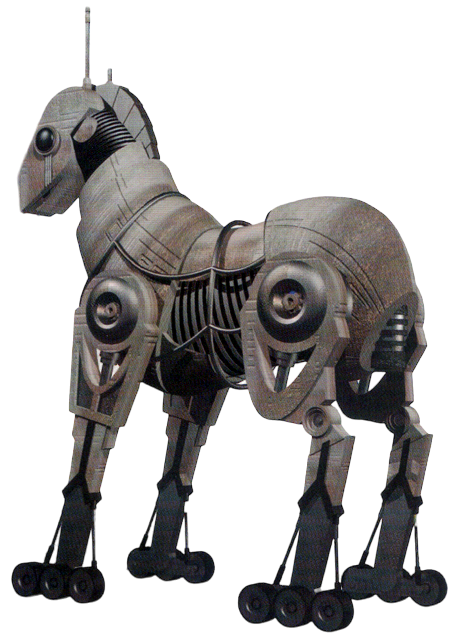A high-tech version of a beast of burden, the PackTrack 41LT-R was a quadrupedal design that mimicked the basic structure of a horse. In place of a fur-covered hide, the PackTrack was covered in ribbed durasteel plating. All of the droid's servomotors or gears were covered by the durasteel plates, or by a double layer of black flexiplast. This had the advantage of making the PackTrack immune to the effects of rain or sand. A head was supported on a powerful neck; the head contained an optical port, auditory sensors, a , and a long-range antenna for transmitting data back to the scout's base camp.

Rear view of a MULE droid
Each of the droid's four legs terminated in three treaded wheels that gave the PackTrack its standard form of locomotion. However, if the terrain proved too rough or hazardous to traverse using its legs, the PackTrack could employ a low-power repulsorlift unit. The droid's legs would fold up against the unit's belly, allowing the repulsorlift to hover the PackTrack up to one meter above the ground. However, the droid's speed while using the repulsorlift was considered to be frustratingly slow.
Most of the PackTrack's internal space was given over to storage; the scout could store provisions, water, equipment, and samples inside two cubic meters of space, with a weight of up to ten kilograms. A heavy lifting claw located between the droid's fore legs could load the heaviest items into the compartment then fold away when not in use. In addition, scouts could lash equipment, such as bedrolls or tools, onto the droid's exterior. The droid could carry an extra forty kilograms of equipment using this method.
The PackTrack was built with reliability in mind, not intelligence. It featured a simple computer brain and no vocabulator. It was not prone to breaking down often, and if something did go wrong, there were few to fix. The PackTrack also featured a self-diagnostic routine that allowed it to assist its owner with field repairs. This feature was accessed by plugging a datapad into a socket behind the droid's head.
The PackTrack 41LT-R was designed to assist scouts during their missions. Scouts were often required to explore planetary terrain for mineral deposits and signs of intelligent life which required them to leave their scout vessels behind for weeks at a time. The PackTrack 41LT-R was intended to be used by scouts to carry their equipment over long distances as a mechanical beast of burden. While organic beasts of burden such as banthas and rontos were in common usage, scouts on the frontier needed a pack animal that was resilient, tireless, obedient, able to carry heavy loads, and was unlikely to die due to contracting an organic virus from the planet's atmosphere or food chain.
The PackTrack 41LT-R was a favorite droid among scouts. They were also used on occasion by the Alliance Special Forces; however, they emitted a detectable repulsor "footprint," and so were only used when necessary.
The PackTrack 41LT-R was originally known as the PackTack 41LT-R when the droid was introduced in 1993s' Galaxy Guide 8: Scouts. This name was used when the droid was mentioned in Rules of Engagement: The Rebel SpecForce Handbook. However, in The Essential Guide to Droids, the name was changed to PackTrack, a spelling that remained constant through its subsequent appearances.
- Galaxy Guide 8: Scouts
- Rules of Engagement: The Rebel SpecForce Handbook
- "Cynabar's Droid Datalog" — Star Wars Adventure Journal 14
- The Essential Guide to Droids
- The Official Star Wars Fact File67
- The Complete Star Wars Encyclopedia
- The Unknown Regions